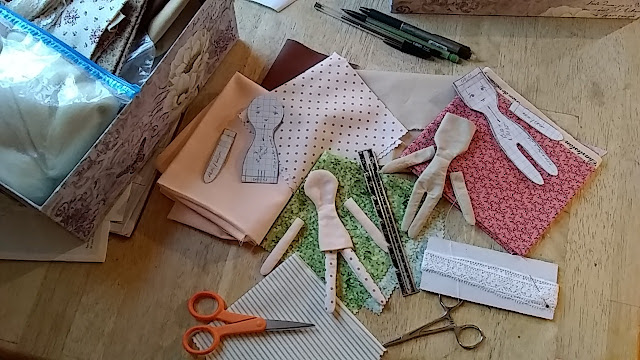The Hitty's Knitty group I belong to had a sew-along the month of February, making tiny cloth dolls. I had forgotten how addictive and fun these tiny dolls are! There are several patterns available to make tiny cloth dolls; most of the members used Ann Wood's Tiny Rag Doll. She is a wonderful little five inch doll with a growing wardrobe. Check out the link to Ann's pattern. I've made this doll (many times!), here are a few of them:
Edith Flack Ackley made several patterns for doll house dolls in the 1930's. Pattern replications are available on Etsy, or you can do a Google search and possibly find one for free.
Another way to make a tiny cloth doll is to reduce a simple rag doll pattern to the size you want. I did this with my Prairie Flowers cloth doll and copy machine! If your doll pattern makes a 10 inch doll, and you want a 5 inch doll, reduce the pattern by 50%. Play around with the percent reduction to find just what you want.
To sew such a tiny doll, either by machine or hand, it is easiest to make sewing templates. Using double sided tape, tape your reduced pattern to cereal box cardboard (a great way to re-use!) and cut out the pattern ON THE SEWING LINE. Place the pattern on your doubled fabric, and use a heat disappearing pen to mark the sewing line all around the pattern (I like Frixon erasable markers by Pilot). Since these dolls are so tiny, don't cut out the fabric, simple put it in your machine and sew around the line you've drawn, then cut out leaving a 1/8 inch seam allowance. With this seam allowance, you won't have to clip curves either!
I made a couple of different cloth doll patterns by modifying a tiny Edith Flack Ackley pattern. For one, I left the bottom of the torso open and made the head round (by tracing around a bottle cap), and for both of them I made separate arms to attach after the body is stuffed.
Something to keep in mind: woven fabric (like broadcloth, muslin, calico) does have a bit of stretch in one direction. Pull your fabric along the grain in each direction to see which direction has the most stretch (don't confuse this with the BIAS stretch). Depending on how you lay your doll out, she will be taller and thinner (stretch running the length of the torso) or shorter and plumper (stretch running the width of the torso). Look at the two doll bodies below:
The very same pattern was used for both. The doll on the left was placed with the stretch grain running side to side, and the one on the right the stretch grain runs the length of the body. There is almost one inch difference in the height of the dolls!
Simple dresses can be made by cutting a waistband to fit around the doll; cut a skirt to gather to the waband, then sew a button and buttonhole loop to the back. She doesn't even need straps to hold up this simple dress.
I made some knit and crochet patterns for these tiny dolls, that should fit Ann Wood's Tiny Rag Doll, and slender bodied Hitty dolls as well:
Tiny Knits for Tiny Cloth Dolls
Enjoy the day!
Update 10/14/2019: Here is another crochet pattern for this tiny cloth doll:
Tiny cloth doll nightgown, shoes, dress, hat
Here is a picture of most of these items









I love the photo of the dolls all in a row with the pretty dresses. It looks like they might do the can-can (laugh). They are adorable.
ReplyDeleteThank you so much, Dorothy!
Deletewarmly,
Beth
Preciosa colección. Me encanta como quedan esas camisetas que haces
DeleteHow sweet!
ReplyDeleteOh you were busy while I was away. Just caught up with this post. They are all so lovely. I haven't even attempted to catch up with the Hitty groups yet - I really do need to though.
ReplyDeleteWhat a fun blog! Love it!
ReplyDelete